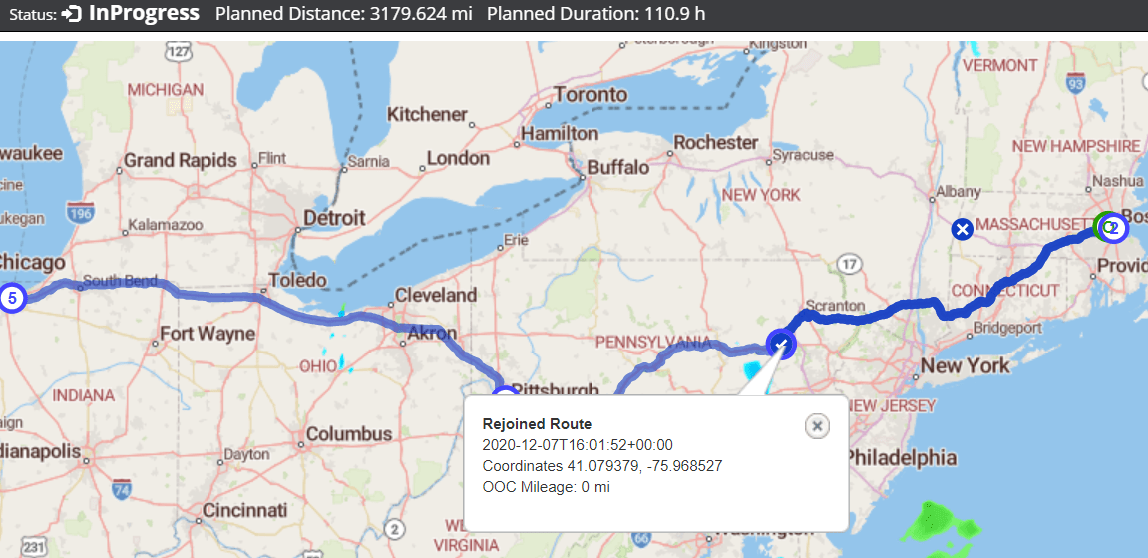Driver Route Compliance
Contents
Many fleets need to keep track of whether their drivers deviate from a planned route, but it isn’t always easy to monitor such events and to understand where, when, and how far the driver went off route.
The Trimble Maps Trip Management API offers a solution to this problem by tracking so-called “Out-of-Corridor” (OoC) events. Trip Management generates “events” for certain scenarios, and an OoC event occurs when a driver deviates from the planned route beyond a predefined distance threshold.
These events can trigger alerts so you are aware of them in real time, or they can be reviewed at a later time and used for driver training and post-trip analysis.
About Trip Management
Trip Management offers functionality to plan, execute, monitor and analyze a trip for a specific vehicle type. Using RESTful APIs, the trip stays active in the Trimble Maps cloud during the entire lifecycle. A unique trip ID ensures the controlling application can load, modify and analyze information for a specific trip.
During execution of a trip (driving), the controlling application can send up-to-date location information via GPS pings. The trip is monitored and Trip Management proactively generates notifications for certain events as they arise. In addition to such event-based notifications, the controlling application can load a series of such events for a given trip once the trip is completed.
Out-Of-Corridor (OoC) event
The OoC event notifies the controlling application if the location received is outside of the planned route by a certain distance threshold. The threshold is defined for all trips of a given fleet but can be overwritten for a specific trip. (For example, a threshold of a few hundred meters/yards is useful to account for slight inaccuracy of GPS pings and to allow the driver small deviations for rest breaks or fueling.)
Trip Management generates two different types of notifications for this use case:
-
OoC event notifications (during trip execution)
- Initiated during trip execution based on location, route path and threshold.
- Typically used to inform the dispatcher/stakeholder if something unusual occurs during execution.
-
Out-of-Route (OoR) trip notifications
- Can be requested after a trip has been executed for post-trip analysis.
- The OoR trip notification provides a summary of the distance driven out of the route corridor (OoC).
How OoC events work
-
When the trip execution (driving) starts, the controlling application sends vehicle locations (GPS pings) in certain time intervals to the Trip Management API.
-
Trip Management calculates trip status/progress with each received location.
-
Based on the defined out-of-corridor threshold, Trip Management generates an event if the reported location is outside of the defined corridor (route plus threshold).
-
Each OoC event is returned with the following information:
- Trip ID - Unique identifier for a given trip
- Trip Status - Shows the status of the trip, e.g. “In Progress”
- Event Type - In this case “OoC”. (Trip Management can generate more than OoC events)
- Out of corridor location (lat/long)
- Date and time of the GPS ping
- Driver ID and Vehicle ID - If defined for the trip. Information is optional
- Start location - Address and cOoRdinates
- Destination location - Address and cOoRdinates
- Out of corridor distance - How far the OoC location is from the planned route path
- URL - The URL links to a view of the map showing the location, making it easy to share the visualisation of the event. The URL link expires after 12 hours.
- Status - The type of event. Two values : “Left route” and “Rejoined Route”
OoC Example - left and rejoined route
Left Route

Rejoined Route

Summary
Trip Management Out-of-Corridor events allow controlling applications to monitor the status of a trip without investing too much effort and resources to develop and maintain an individual monitoring system. The controlling application stays on top of the trip status and fleet owners can receive warnings and notifications when the “unexpected” happens.
Post trip analysis becomes easy using the OoR (out-of-route) trip report to understand the mileage driven outside of the planned route.
For more information, please see:
Trip Management API Documentation
Share this article: